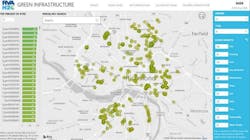Revolutionizing green infrastructure: Digital tools for planning, design insights and transformative applications
The impact of urbanization on watersheds is typically evaluated by examining changes in stormwater quantity and quality. Historically, stormwater management relied on the “design storm” approach, leading to the construction of thousands of stormwater control measures (SCMs), such as detention and retention ponds. These SCMs were implemented at both site-specific and watershed scales (e.g., regional ponds) to reduce flood risks and, in some cases, enhance water quality. Early stormwater management practices prioritized the efficient collection, conveyance, and discharge of runoff (Prince George’s County, MD, 1999). However, this approach faced regulatory constraints that limited the development of regional ponds. Furthermore, SCMs implemented at a site-scale without master plans were not always successful in improving water quality or reducing flood risks. Additionally, implementation challenges sometimes resulted in the degradation of streams located downstream of these SCMs.
In the late 1980s, Prince George’s County, Maryland, along with other municipalities in the Metropolitan Washington, D.C. area, began developing a SCM known as bioretention. The goal was to design bioretention systems that mimic pre-development hydrologic conditions. These systems, paired with a low-impact development (LID) approach, integrate hydrologically functional site designs with pollution prevention strategies to mitigate the effects of development on hydrology and water quality (Prince George’s County, MD, 1997). This approach helps maintain pre-development stormwater runoff volumes, peak runoff rates, and frequency. A key innovation of this strategy was shifting stormwater management to small, cost-effective SCMs (e.g., bioretention facilities) located on individual parcels, rather than relying on large, expensive ponds at the bottom of sub-watersheds that are fed by extensive pipe networks.
Since then, bioretention and other SCMs that utilize infiltration, filtration, and vegetation to treat pollutants and reduce runoff volumes have been collectively referred to as “green infrastructure.” Over time, the range of available SCMs expanded, with design manuals in states like Maryland and Pennsylvania (PACD, 1998) providing detailed criteria and specifications for various green infrastructure practices. These include bioretention, permeable pavement, constructed wetlands, riparian forest buffers, stream restoration, rooftop runoff management systems, sand filters, and many other innovative approaches to sustainable stormwater management.
Over the past 10 to 15 years, the need for innovation in SCMs planning and design has grown in response to evolving challenges such as climate change, extreme weather events, expanding impervious surfaces, and increasing waterway pollution. The role of SCMs, particularly green infrastructure, has significantly evolved, gaining recognition as a critical tool for reducing pollution, protecting waterways, managing combined sewer systems (CSSs), and enhancing resilience and flood risk management strategies (WEF et al. 2022). More importantly, well-planned and effectively implemented SCMs, including green infrastructure, can serve as powerful catalysts for adapting to changing precipitation patterns caused by climate change while driving economic development in urban areas.
The demand for innovation remains critical, and in today’s era of Artificial Intelligence (AI), digital tools are revolutionizing the planning and implementation of green infrastructure. Let’s explore several transformative applications of green infrastructure, emphasizing our belief that stormwater management—and green infrastructure specifically—can greatly benefit from these advancements.
The role of digital tools in green infrastructure planning
Richmond, Virginia, RVAH2o Green Infrastructure Master Plan
Traditional green infrastructure planning involved GIS desktop analysis and field screening of sites. This traditional approach has significantly evolved with the availability of new technology and digital tools. These tools are more efficient in identifying feasible sites, facilitate user involvement, and reduce planning costs. For example, the city of Richmond, in coordination with the Alliance for the Chesapeake Bay, and with Arcadis’ support, recently developed the RVAH2O Green Infrastructure (GI) Master Plan to expand and accelerate the goals and mission of the RVAH2O program and the Alliance’s mission to improve the lands and waters of the Chesapeake Bay watershed.
The city has the first Virginia Pollutant Discharge Elimination System (VPDES) permit in the Commonwealth of Virginia that integrates wastewater, stormwater and a combined sewer system into one watershed management program for a more efficient and holistic approach to water systems management. The city’s Integrated Permit has requirements to achieve the reduction of pollutants to the maximum extent practicable (MEP) in compliance with the Chesapeake Bay total maximum daily load (TMDL). In 2014, to address stormwater quantity and discharge quality issues, DPU initiated RVAH2O (https://rvah2o.org/), which is a citywide effort to implement solutions, disseminate outreach information, and facilitate ongoing communication and partnership projects with stakeholders. As part of RVAH2O and their RVA Clean Water Plan, DPU has actively promoted the use of GI.
The goal of the RVAH2O Green Infrastructure Master Plan is to identify opportunities to incorporate GI in public parcels and in the right-of-way to reduce stormwater quantity and improve water quality.
Master plan approach: A digital Green Infrastructure Ranking Tool (GI Ranking Tool) for ranking and prioritizing public parcels with the greatest potential for implementing GI was developed for the city’s three most heavily polluted watersheds: Cannon’s Branch/Shockoe Creek, Gillies Creek, and Manchester Canal/Goose Creek. These three priority watersheds identified in the RVA Clean Water Plan contain 537 public parcels and are prone to flooding due to the age of their collection systems and proximity to the James River.
GI types used in the plan: GI can be used to complement gray infrastructure and add capacity to collection systems. The two primary GI types preferred by city staff and considered in the plan are permeable pavement systems and bioretention.
Permeable pavement systems, which include permeable asphalt, concrete and pavers, were selected because DPU has sufficient equipment and staff for maintenance. Bioretention was selected as it provides desirable vegetation and water quality treatment benefits. Additional GI practices favored by DPU include reforestation and tree plantings, which can help meet RVA Clean Water Plan and other city goals for increasing tree canopy and reducing the urban heat island effect, and rainfall harvesting devices, such as cisterns and rain barrels, which have small footprints and can be added adjacent to structures even in highly urban areas.
RVAH2O Green Infrastructure Ranking Tool: Though designing and implementing GI has become more mainstream, retrofitting GI in developed areas still poses challenges due to existing utilities and infrastructure, lack of suitable soils and slopes, and several other potential surface and subsurface constraints. To identify and evaluate favorable potential GI locations, the plan used a five-step geographic information system (GIS) site screening approach using subsurface and surface infrastructure data from the city.
The GI Ranking Tool evaluation and analysis process included the following five phases:
- Phase 1: Flow availability – Screened parcels and runoff catchments based on tributary volume.
- Phase 2: Site availability – Determined availability of adequate space for various GI types.
- Phase 3: Site suitability – Screened out unsuitable locations based on exiting conflicts with surface functions and subsurface structures, such as trees and exiting utilities.
- Phase 4: Score GI performance – Identified sites based on estimated benefits.
- Phase 5: Select target GI – Selected target sites for GI conceptual design development.
Performance criteria: Eleven different metrics for GI performance scoring were used to select sites for the GI Ranking Tool. Each was assigned to one of four tiers based on importance to the project team and feedback from other city departments.
Following the scoring of GI sites in public parcels and the right-of-way using the performance criteria, projects in qualified sites were ranked for each GI type evaluated, as shown in Table 2.
Results: Bioretention in open areas of public parcels and the space between the curb and sidewalks in the right-of-way had the highest number of qualified sites for incorporating GI. Bioretention in parking lots and green alleys had significantly smaller numbers of qualified sites. The GI Ranking Tool was used to produce maps for each GI type evaluated to show the ranking of sites.
The optimal parcels and areas identified for the different GI types are available for evaluation by city departments using the following two tools:
- ARCGIS maps that have been created for each of the GI types to allow for the evaluation of individual sites; and
- A Power BI interface that has been created to allow for city users to conduct evaluations and comparisons across multiple sites and GI types.
Stakeholders outside of the city can work together with DPU or other city departments to gather and evaluate GI ranking information.
The ARCGIS maps allow users to navigate using Google Earth to zoom in on individual parcels and observe site features and potential site constraints and view the scoring of any site. It also allows individual layers, such as utility conflicts, to be turned on and off for clarity or to look at specific criteria.
The Power BI interface provides a more robust companion piece to the ARCGIS maps and makes the plan a living and interactive tool. Criteria scoring and weighting information for parcels and GI types can be accessed and modified by the user using the Power BI interface. A screenshot of the Power BI interface is shown in Figure 1. These two tools make it easy for city staff to evaluate optimal locations for GI.
Washington, D.C. (DDOT stormwater management & green infrastructure design project)
A similar tool was used in Washington DC, in support of a green infrastructure project for the DC Department of Transportation (DDOT). The project included planning and design of green infrastructure across 2,000 acres of four sub-watersheds. The Arcadis team in coordination with DDOT developed a GIS tool to assess, evaluate, and select locations to manage runoff across 10-acres of impervious surfaces using GI practices including bioretention, rain gardens, porous pavement, pavement removal & disconnections, tree pits and green alleys. Utilized the GIS data layers and defined screening and scoring criteria for several contributing factors to rank or eliminate potential locations for GI along the DDOT right-of-way.
Using the GIS site screening and scoring process, the team narrowed down GI locations in a significantly large area and saved time and effort on field inspection.
Key benefits of using digital tools in green infrastructure planning
- Enhanced efficiency and collaboration: Digital tools streamline green infrastructure project planning, improving accuracy and fostering stronger collaboration among teams.
- Climate resilience integration: Seamlessly incorporate climate resilience considerations into GI strategies, ensuring long-term sustainability.
- Strengthened stakeholder engagement: Foster better communication and collaboration with agencies and stakeholders, building stronger partnerships.
- Real-time monitoring and adaptation: Leverage digital platforms for continuous monitoring and adaptive management, ensuring projects meet program goals.
- Dynamic master planning: Create a living Master Plan that evolves to meet changing needs and priorities over time, and that can be updated as needed.
Lessons learned from GI design programs
Philadelphia and New York City have implemented successful green infrastructure (GI) programs to address stormwater management and enhance urban resilience.
Philadelphia: The city launched its landmark Green City, Clean Waters program in 2011, aiming to reduce stormwater runoff and combined sewer overflows (CSOs) through GI investments. Initiatives include green roofs, rain gardens, permeable pavements, and tree planting, successfully managing over 3,200 acres of impervious surfaces and leveraging community engagement for sustainable urban development.
Lessons learned in Philadelphia include:
- Success in scaling GI through the Green City, Clean Waters initiative. The city uses a 3-tier approach for GI implementation: public projects, regulations and standards for developers, and a grant program. A large percentage of the improvements and implementation come from the developers with minimal cost to city.
- Challenges in balancing performance monitoring with maintenance needs. GI, like any other infrastructure, requires maintenance. Therefore, it is critical to identify who will maintain GI and allocate adequate budget to create a sustainable O&M program.
New York City: NYC’s Green Infrastructure Program focuses on reducing CSOs and improving water quality through innovative GI projects like bioswales, green streets, and blue roofs. Since its inception in 2010, the program has installed thousands of GI assets citywide, integrating GI into urban planning and fostering partnerships with local communities to build a greener, more climate-resilient city.
Georgia: Dalton, Georgia, has developed a stormwater management program aimed at addressing water quality and flooding challenges associated with urban runoff. As a smaller city, Dalton leverages strategic planning and community involvement to comply with state and federal regulations. One notable project in Dalton involved retrofitting a degraded stormwater channel with a regenerative stormwater conveyance to reduce erosion and improve downstream flooding conditions. This collaborative effort between the city and residents provided immediate flood mitigation and water quality improvements through sedimentation control.
Key common themes and lessons learned from GI programs
- Engaging stakeholders early in the process helps build consensus and ensures stronger buy-in.
- Prioritizing long-term maintenance and performance tracking—particularly when integrated with a stormwater asset management program—reduces costs over time and drives program success.
Transformative applications
Green Infrastructure is rapidly advancing and transforming, driven by a growing recognition of its critical role in addressing the complex challenges outlined earlier. To achieve sustainable and impactful solutions, a strategic integration of green and gray infrastructure is essential, creating a balanced and resilient approach that ensures long-term program success. Below are compelling examples of innovative and transformative applications that demonstrate this synergy:
Regenerative Stormwater Conveyances (RSCs)
- A hybrid solution combining natural systems with engineering approaches. RSCs treat and convey stormwater through a combination of sand, wood chips, native vegetation, riffles (with either cobble rocks or boulders), and shallow pools. RSCs are designed to convey water while minimizing the effects of erosion (VADEQ, 2024).
- Case studies have been successfully implemented in Maryland, Virginia, Georgia, and other states. In 2024, Virginia incorporated RSCs in the new Stormwater Management Handbook developed by the Department of Environmental Quality.
Nature-based solutions
- Nature-based solutions are actions to protect, sustainably manage, or restore natural or modified ecosystems to address societal challenges such as reducing risks from natural hazards or improving air quality and simultaneously provide benefits for people and the environment (IDA, 2024).
- A recent report prepared by the Institute for Defense Analyses, titled Nature-Based Solutions, Evidence for Hazard Risk Reduction and Ecosystem Services is an initiative of the White House Office of Science and Technology Policy (OSTP) to advance the Nature-Based Solutions Roadmap. The report indicates that climate change, development in hazard-prone areas, and the loss of services provided by natural systems are increasing risks to people, infrastructure, and economies. To manage these risks, we need to understand the performance of engineering systems (such as built or grey infrastructure) and nature-based solutions (such as green infrastructure) and how to best use them (IDA, 2024).
- This report integrates academic and practitioner perspectives to evaluate the effectiveness of 23 nature-based solutions to address 7 hazards and provide 4 ecosystem services. This is an example of the need to continue to innovate nature-based solutions to leverage their benefits.
Emerging innovations
There are many emerging innovations that are transforming stormwater management and the use of green infrastructure. The following are examples of these innovations:
- Smart GI Systems: Integration of IoT and sensors for real-time monitoring and adaptive management.
- Decision support platforms and digital twins: Platforms to truly learn how the stormwater systems, including green infrastructure are performing. These platforms can also be linked to stormwater asset management systems to improve operations and maintenance activities while reducing costs.
- Resilient GI Designs: Re-inventing green infrastructure so it can be tailored for flood mitigation and urban heat island reduction.
Conclusion
The future of stormwater management is full of promise. As a sector, we must continue to embrace digital tools and champion the adoption of advanced modeling and data visualization technologies. By learning from experience and leveraging insights from leading green infrastructure programs, such as the examples highlighted above, we can avoid common pitfalls in planning, design, and maintenance. At the same time, innovation and forward-thinking must remain at the core of our approach to green infrastructure implementation. By doing so, we can effectively tackle the dual challenges of stormwater management and climate resilience—building stronger, more resilient cities, all while improving quality of life for all.
References
- Institute for Defense Analysis (IDA), Science and Technology Policy Institute. 2024. Nature-Based Solutions, Evidence for Hazard Risk Reduction and Ecosystem Services.
- Prince George’s County, MD, Department of Environmental Resources, July 1999. Low Impact Development Hydrologic Analysis.
- Prince George’s County, MD, Department of Environmental Resources, November 1997. Low Impact Development Design Manual.
- Pennsylvania Association of Conservation Districts (PACD), Inc.; Keystone Chapter, Soil and Water Conservation Society; Pennsylvania Department of Environmental Protection; Natural Resources Conservation District, CH2M HILL, Spring, 1998. Pennsylvania Handbook of Best Management Practices for Developing Areas.
- Virginia Department of Environmental Quality, 2024. Virginia Stormwater Management Handbook, Version 1.1.
- Water Environment Federation, American Society of Civil Engineers, Environmental & Water Resources Institute. 2022. Urban Stormwater Controls Operations and Maintenance (WEF Manual of Practice No. 39, ASCE/EWRI Manuals and Reports on Engineering Practice No. 153). Water Environment Federation.
About the Author

Nirali Desai
Nirali Desai, P.E.is a principal Engineer at Arcadis.


Fernando Pasquel
Fernando Pasquel is senior vice president at Arcadis.



